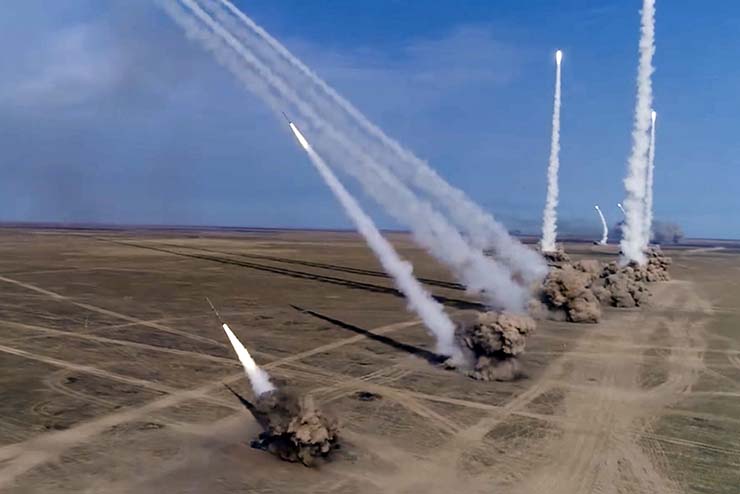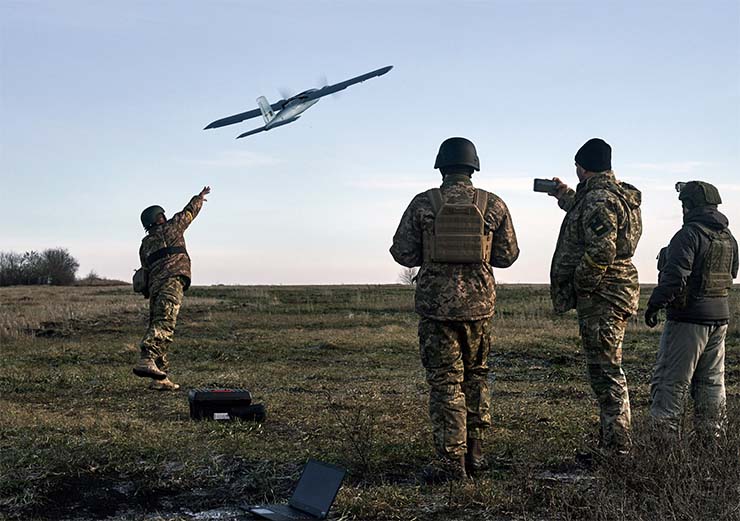
The role played by new technology, including the use of satellites, drones and hypersonic missiles, in the Ukraine war is an example of 21st century warfare. But it also has a mix of 20th century warfare. The importance of ground defences and the need to physically capture objectives and hold them continues to be of importance although the air, ground, sea, cyber, space, electromagnetic domains are fully activated, with information warfare is optimised. America is continuing to fuel its proxy war against Russia in Ukraine, while US-NATO appears keen for similar conflict with China in the Indo-Pacific. There are increased chances of a global war. Nations big and small are going full swing in developing future technologies and weapon platforms with greater kill probability.
The Chinese invasion in Eastern Ladakh during 2020 came as a rude shock to us, resulting in a scramble to weaponise the armed forces. Following the hi-tech war in Ukraine, India has opened up participation of the private sector in defence and is focusing on new technologies. Swarm drones have already been fielded in the Indian Army. There is emphasis on being Aatmanirbhar in defence. However, Parliament’s Standing Committee on Defence pointed out1 that armed forces should have one-third of its equipment in the vintage category but the Indian Army still holds over 60 per cent vintage equipment. The Committee also recommendsed separate defence allocation be earmarked for “Committed Liabilities” and “New Schemes”.
The Indian military is incorporating artificial intelligence (AI) keeping in mind its development, use and robust processes to ensure AI algorithms are trustworthy. Concurrently, the manpower is being trained to use these systems. AI has been in use in fields such as computer vision and speech recognition, and is being optimised for decision making. However, a major global concern is AI systems becoming autonomous and making decisions without human supervision, which can have dangerous consequences in military operations.
The Army has established a quantum computing lab with assistance from the National Security Council Secretariat. News reports of May 5 this year have called 2023 as the year of transformation for the Army2. With the Network for Spectrum (NFS) project to ensure adequate bandwidth for the military, the report talks of various operational information systems (OIS), as well as systems to improve logistics, maintenance and the like. Some of these have been ongoing for years, for example, Army’s Combat Information Decision Support System (CIDSS) sanctioned in 1999 is now renamed as Situational Awareness Module for the Army (SAMA). Similarly, the Battlefield Surveillance System (BSS) has been ongoing from early 2000s.
The delay in developing the OIS has been because of bureaucratic red tape of the Ministry of Defence (MoD) and by the DRDO, latter on the plank of security although the DRDO’s Centre of Artificial Intelligence and Robotics (CAIR) outsources development of security solutions. What could be more ironic than the Battlefield Management System (BMS), categorised as “high-priority” ‘Make’ project foreclosed in early 2018 for lack of funds after 13 years of development and having spent crores of rupees on the project3. Pakistan’s Integrated Battlefield Management System (IBMS) was already fielded by then. In our case, the Artillery Combat Command Control and Communication System (ACCCS) is the only OIS fully fielded in the Army.

While we are investing in new technologies and weapons, we must keep abreast with developments around the world, including in China. Not only has China 24×7 satellite surveillance astride our borders, it recently tested AI control of its satellite ‘Qimingxing-1’ to observe military areas in Bihar (India), as also Japan4. In 2022, China’s CH ‘Rainbow’ drone was observed flying over the Kailash Range and Pangong Tso in Eastern Ladakh.
We have also developed the prototype of an indigenous high altitude platform5 and all types of drones are being designed and produced. But Poseidon drones, capable of flying 4,000 km up and transmitting a clear picture, are already in service with the artillery brigade and reconnaissance battalion of the Armed Forces of Ukraine6.
China could employ drones in thousands against our frontline troops at chosen points along the Line of Actual Control (LAC) in conjunction with attacks by bigger drones, which could also be in swarms. We could be faced with a situation like Ukraine in the next conflict with China, which may be forced by Beijing in the near future. China should be expected to employ swarms both during missile and drone attacks. In what stage are we to acquire an anti-swarm drones system?
Our focus must now be to speedily develop a range of hypersonic weapons in large numbers, as well as research on how to intercept not just ballistic missiles but also hypersonic missiles keeping impossibility of the latter aside. In developing hypersonic weaponry, numbers will matter since China follows the concept of swarm attacks. Also, China could well use a mix of conventional and low-yield nuclear warheads in hypersonic missiles, in addition to purely nuclear warheads. It would be prudent for us to plan similarly.
This also leads us to the question whether we are equipping our forces in “adequate” numbers (drones included) or is this being sacrificed at the altar of exports? We need to be more careful in exporting indigenous technology. Our exports of the ‘Swathi’ weapon locating radar already been compromised to the benefit of China-Pakistan7.
Military hardware being exported by India include missiles, advanced light helicopters, offshore patrol vessels, personal protective gear, surveillance systems, and a variety of radars are good pointers but our policy makers fail to acknowledge that defence exports by themselves don’t make a nation militarily strong and without military strength India cannot become one of the most powerful nations of the world. The modest hike in Defence Budget 2023-2024 despite continued confrontation with an aggressive China is certainly not taking India on the path to become a militarily strong nation.
In terms of R&D, the government had announced an allocation of 25 per cent of the defence R&D budget to Industry, startups and academia in the 2022-23 but this has not yet been implemented for industrial R&D towards development of indigenous products and platforms with IP control. In Defence Budget 2023-2024, DRDO’s allocation is enhanced by 9 per cent (total Rs 23,264 crore) but insufficient budget for prototype development continues to plague the system especially with the industry neither incentivised to undertake in-house R&D nor government funded to undertake high-risk platform-level development of technologies and design-development of Indian equipment and platforms. This is an example of impediments in optimising Aatmanirbhar Bharat and becoming one of the most powerful nations of the world. Besides, defence exports should not be hostage to any ballpark target figure by a certain year mentioned off the cuff by the Prime Minister a few years back but based on operational realities; defence exports at the expense of equipping the military just to please the Prime Minister must be avoided.
On February 25, 2023, China successfully tested its new long-range Dongfang ‘DF-27’ hypersonic intermediate-range ballistic missile (IRBM), which has a range of 8,000 km. Being manoeuvrable, it can possibly target US aircraft carriers successfully, as well as other targets evading the US ballistic missile defence systems. China could use the DF-27 IRBM to invade Taiwan. All targets in India and beyond are also within the strike range of the DF-27 IRBM8. China’s hypersonic glide vehicle-equipped DF-41 ICBM with an operating range of 15,000 km can reportedly carry 10 independently targetable nuclear warheads to attack any target on the planet. China also has the YJ-21 anti-ship hypersonic missile that can hit target at a speed of 3,400 metres per second; travelling at Mach 6 during the trajectory and then Mach 10 at terminal velocity.

India is aware of Chinese presence in the Indian Ocean and China’s formidable plans in the future. Our naval strength is being expanded albeit at slow pace. Ironically, our government slashed the SSN project in 2019 to just three SSNs citing high project costs but even this Rs 48,000 crore project to build 3 x SSNs has been pending Cabinet Committee on Security (CCS) approval since then9.
Against the required 42 operational fighter squadrons, the Indian Air Force (IAF) currently has 31 fighter squadrons and with the impending retirement of three squadrons of vintage Mig-21 by 2025, IAF will be left with less than 30 squadrons, since replacements for the series of MiG combat aircraft have not been procured. We have much catching up to do with China, which in February 2023, shared its six-generation fighter aircraft concept on social media.
Space warfare is being witnessed in Ukraine with hundreds of StarLink satellites launched by Elon Musk to assist Ukrainian forces and counter actions by Russia. China has developed not only ASATs (which India also has) but also space weapons and technologies to kill or capture enemy satellites, as also space-based weapons. We must develop such capabilities speedily, for which ISRO must be given specific time-based tasking and necessary funds. In terms of cyber warfare and the electromagnetic domain, we need to do a lot to bridge the asymmetry vis-a-vis China.
Finally, we need to focus on achieving an effective soldier-machine mix, especially when dealing with adaptive machines intelligence systems. Ironically, the ‘Agnipath’ concept with ‘Agniveers’ joining the forces with just 4-month basic recruit training is a retrograde step, notwithstanding the Army Chief eulogising this concept for earning political brownies. Unfortunately, many policy makers tend to believe that bulk of the military tasks and most fighting can be taken on by AI-enabled machines.
We must acknowledged that 100 per cent automation of the battlefield is not achievable and in our case achieving a high degree of automation of the battlefield is also decades away. Besides, achieving the requisite soldier-machine systems mix is a complex issue which even developed nations are struggling to perfect; the problems being both technical and psychological in nature, especially when dealing with adaptive machines intelligence systems. In addition are the soldier’s cognitive limitations that would arise in the control and interaction interface linking soldier controllers and the machine systems they control. Neglecting the man behind the machine is going to cost us dearly in war.
References
- (chrome-extension://efaidnbmnnnibpcajpcglclefindmkaj/https://loksabhadocs.nic.in/lsscommittee/Defence/17_Defence_36.pdf)
- (https://www.timesnownews.com/india/2023-to-be-year-of-transformation-for-indian-army-list-of-key-projects-article-100021875)
- (https://www.spslandforces.com/story/?id=481&h=Foreclosure-of-Armys-Battlefield-Management-System)
- (https://www.indiatimes.com/technology/news/chinas-ai-controlled-satellite-observes-india-599549.html)
- (https://www.spsmai.com/experts-speak/?id=1306&q=Indigenous-High-Altitude-Platform)
- (https://twitter.com/kvistp/status/1654454479310258177?s=46&t=Dw8xQEAL7Yvq5lfVlCH9hg)
- (https://www.spsmai.com/experts-speak/?id=1290&q=Export-with-Care)
- (https://eurasiantimes.com/china-tested-new-df-27-hypersonic-icbm-that-can-penetrate/)
- (https://www.spsmai.com/experts-speak/?id=1322&q=Indigenous-SSN)
-The author is an Indian Army veteran. The views expressed are personal and do not necessarily reflect the views of Raksha Anirveda








